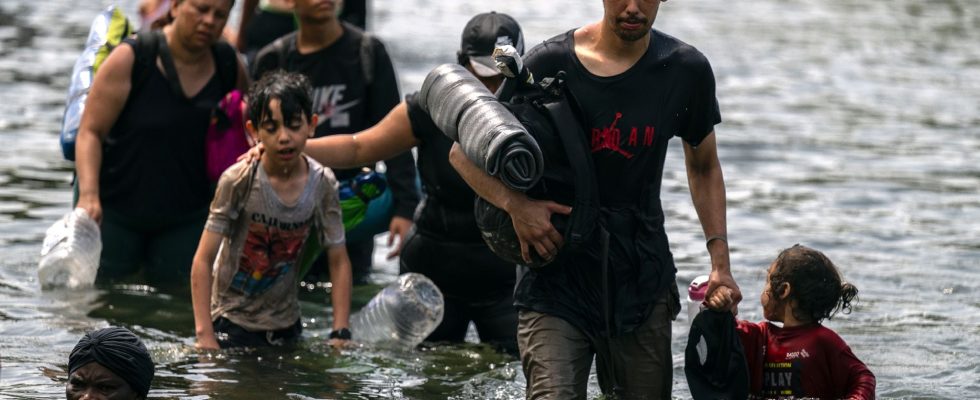In the mornings, around 7 a.m., the Necocli pier looks like a beehive. Pedro Carrillo makes his way between the travelers who are preparing to leave for the great journey to the United States. The first stage of their dangerous journey consists of a ten-hour boat crossing across the Gulf of Uraba. They will then reach the town of Capurgana, 70 kilometers away – also in Colombia, but on the Panamanian border. Then, another natural obstacle awaits the migrants: the Darien forest. In Panama, this thick mountainous jungle, as vast as Belgium, constitutes a natural barrier that no road has ever crossed. Then he will have to travel through all the other states of Central America – Costa Rica, Nicaragua, Honduras, Guatemala, Mexico – to reach Texas, at the end of a journey of 3,500 kilometers and several weeks.
For the moment, Pedro Carrillo is content to approach passengers to sell them trash bags, essential to protect luggage on board the boat. But soon, he too will set off. This thirty-year-old Venezuelan has been sleeping in a makeshift tent pitched on the nearby beach for a month while waiting to cross the Gulf of Uraba. “I’m trying to make a little money to pay for the crossing,” explains the temporary resident of Necocli, the small fishing port that has become an international “hub”.
In ten years, 216 times more migrants
Crossing the Darien is not a new phenomenon. “Remains from the Mayan era [NDLR : qui a duré quatre millénaires, jusqu’en 1520 après J.-C.] attest to human passages in the region”, notes social science researcher Marilou Sarrut. But in recent years, the flow has taken on an unprecedented scale. While the Panamanian authorities recorded an average of 2,400 arrivals per year between 2010 and 2014, the figure rose to 30,000 in 2015-2016. Six years later, in 2022, 250,000 migrants took the Darien route. And last year, it was more than 520,000! In 2024, Panamanian authorities predict a further increase of 20%.
This boom made Necocli’s fortune. Camping stores have mushroomed. All sell tents, headlamps, hiking shoes, mosquito repellent, etc. Jesus, a trader, almost complains about the competition. “A few years ago, there were almost no stores like ours; today, it is becoming difficult to differentiate yourself.” Unless, of course, you get into the hotel business. The sector has exploded. Many locals, like the sixty-year-old Gloria, offer rooms to the wealthiest migrants. “Some residents return to live with their parents to rent out their entire house and earn even more money!”, the old lady is surprised.
But who are these customers who dream of America? Venezuelans form the largest contingent: last year, there were 328,000 of them crossing the Darien, or 60% of the total. Next come Ecuadorians (57,000) and Haitians (46,000). Necocli is a tower of Babel: “People come from everywhere,” Gloria continues. “There are Afghans, Indians, Turks, Uzbeks, Nigerians and I forget some.” Among non-Latinos, the most numerous are Chinese. Last year, more than 25,000 attempted the adventure.
Leaving Canton, Liu passed through Casablanca, in Morocco, then Quito in Ecuador, before landing at Gloria. “You have to take detours so as not to attract the attention of the Chinese authorities,” explains the young Cantonese who wishes to remain anonymous so as not to attract trouble to his relatives who remain in China. “I don’t agree with the social control put in place by our government. So I left. In the United States, I want to live freely,” he explains. Researcher Marilou Sarrut, who spent many months studying Necocli, saw many of her compatriots pass by, disgusted by Xi Jinping’s dictatorial system. “With Covid, some people took the plunge and said to themselves: ‘I will no longer live in China.’”
The road of terror
Like Venezuelans and other migrants, these Chinese are aware of the dangers that await them. “In addition to natural risks and diseases, there is banditry,” explains Marilou Sarrut. “Because Darien is an area beyond state control.” On the Colombian side, the first section of the journey, that is to say the crossing of the Gulf, is managed by the ex-paramilitaries of the Clan del Golfo. Once in Panama, the migrants cross paths with “a multitude of armed bands, with little hierarchy, who apply a regime of terror.” Migrants who arrived safely reported scenes of racketeering, physical violence and assassinations. Doctors Without Borders has counted 676 acts of violence in 2023, a third of which were of a sexual nature.
On the pontoon at the port of Necocli, Pedro Carillo says he is ready to risk his life: “What I fear is not the jungle, but staying here, not having a job, being hungry and I am forced to return to Venezuela.” So he continues to sell plastic bags for a few pesos. A “business” which, for sure, will never allow him to afford the “VIP route” to Panama, the one generally taken by the Chinese, more fortunate than the Latinos. For 800 dollars, Xi Jinping’s compatriots follow the coastal route, the safest, because it consists of numerous maritime hops along Panama. To cross the jungle, infested with mosquitoes and thieves, the Venezuelan will have to pay the sum of 300 dollars to his smugglers. A fortune for him who dreams of the promised land.
.
